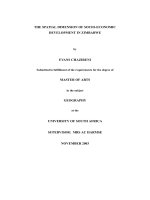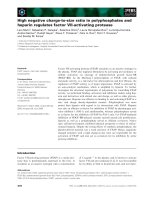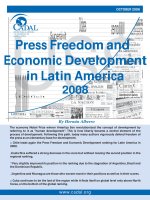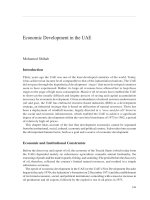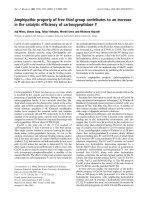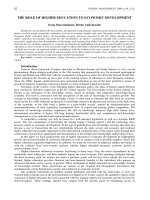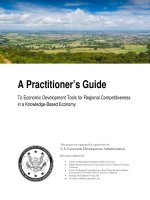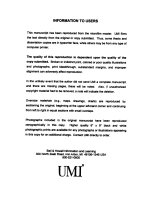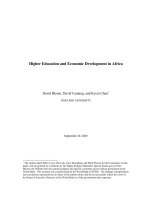Building industrial zones solution to economic development in rural and mountainous locations of Dong Nai province
Bạn đang xem bản rút gọn của tài liệu. Xem và tải ngay bản đầy đủ của tài liệu tại đây (259.73 KB, 69 trang )
1
2
3
4
Firstly, I’d like to express my great thankfulness to all
directors, professors, tutors, and coordinators of the MMVB
program.
And to Dr. Tran Thanh Xuan, who has devotedly
counselled me to finish this thesis.
And also to all organizations and individuals
enthusiastically help me during my course and especially in
my time to fulfil the thesis.
Although I have already made my all efforts, the thesis
may still have some shortcoming. I do hope to get advices
from the Examiners’ Board, from professors and from all
classmates,…in order to well better my thesis.
Finally, I’d like to wish healthy, happy and successful
to all of you.
Ho Chi Minh, Feb. 2007
Nguyeãn Ñöùc Trí
5
1. Research rationale 1
2. Research Aim, Object, and Scope 2
3. Research Methods 3
4. Contributions 3
5. Basic concepts 3
6. Research Structure 5
6
1.1.1 Role of Industrial Zones, Export Processing Zones in the Process of
International Economic Integration and International Labor
Arrangement
6
1.1.2 Viewpoints of Vietnamese Communist Party and State on developing
and managing Industrial Zones, and Export Processing Zones
9
11
1.2.1 Socio-economic Development requires the balance, and harmony
between Cities and Rural Areas
11
1.2.2 Specific characteristics of Dong Nai Province and Economic
Development Model in rural areas
12
1.2.3 Objective factors for Industrial Zones Development in rural
mountainous districts of Dong Nai Province
13
16
2.1.1 Dong Nai’s Overview 16
2.1.2 Planning and developing Industrial Zones in Dong Nai 17
31
6
2.2.1 Development situation of Industrial Zones in rural mountainous areas 31
2.2.2 Review of Achievements, Shortcomings and Causes 38
2.2.2.1 Achievements 38
2.2.2.2 Shortcomings need to be improved 43
46
3.1.1 Focal Industrial Zones Development is indispensable trend in the
process of industrialization and modernization
46
3.1.2 Criteria for orientation of Industrial Zone Development 46
48
3.2.1 Orientation of Industrial Zones Development in Dong Nai Province
to the year 2010
48
3.2.2 Plan and development of Industrial Zones to 2010 49
3.2.3 Forecast of Labor Demand in Industrial Zones in Dong Nai Province 51
52
3.3.1 Solutions to plan, site clearance, compensation and finding out the
capital for infrastructure investment
52
3.3.2 Link the enterprises in the Industrial Zones with local materials – the
solution of Industry-Agriculture-Forestry-Fishery
53
3.3.3 Environment Protection Solution 54
3.3.4 Solution to train and enhance human resources quality in rural
mountainous districts
56
3.3.5 Solutions to social issues in the process of Industrial Zones
Development
58
59
A
NNEXES
7
- Vietnam has been, in recent years, continuously in its process of
“Industrialization and Modernization” in which agricultural modernization in rural
areas is the issue attracting remarkably the concerns of the Government. This was
emphasized again in the Document of Tenth Vietnamese Communist Party
Congress: “Our policy is to further speed up industrialization and modernization
of rural agriculture, solves synchronously problems related to agriculture, rural
areas, and farmers. We have to develop agriculture comprehensively, and
transform effectively the agricultural structure and rural economy in the direction
of making more and more added value. This development must be suitable for
processing industry and market; ”.
- Dong Nai belongs to the focal economic region of the South-East
Vietnam. Dong Nai, together with Ho Chi Minh City, Binh Duong, and Ba Ria-
Vung Tau made up the “motive force” implementing the process of
industrialization and modernization in the South Vietnam and nationwide in
general. For this reason, developing, and transforming the economic structure in
the direction of increasing the portion of industry and service as well as
developing in comprehension and balance between cities and rural areas are
urgent missions of the Province.
- In reality, economic development in Dong Nai is not synchronous. The
gap of living standard and infrastructure between cities and rural mountainous
areas is quite wide. Dong Nai also has the largest potential of agricultural land
compared with other provinces in the South-East Vietnam. Therefore, developing
Industrial Zones in rural mountainous areas is the effective solution to make
8
balanced development in the areas; this is the way to further promote economic
potential as well as exploit effectively the local resources.
- Based on the Central Party’s Solution, Chairman of Dong Nai Province
People’s Committee issued Decision No. 4832/QÑ.CT.UBT dated December 30,
2002 on establishing Center for Developing Rural Mountainous Industrial Zones
under Dong Nai Industrial Zones Authority (DIZA). The major mission of this
center is to develop infrastructure and attract investment to rural industrial zones
among which Industrial Zones of Xuan Loc, Tan Phu, Dinh Quan are very first
examples.
- The purpose of developing industrial zones in rural mountainous districts
is to transform economic structure, further promote the industrialization through
infrastructure development, investment attraction, especially foreign investments.
From this process, we enhance the effectiveness of land use, generate more
stable employment for local laborer, transform local economic structure in the
direction of increasing the labor portion in industry and service.
- In addition, the research will contribute to the effective and sustainable
development of these Industrial Zones.
- Development of industrial zones in rural mountainous areas of Dong Nai
to attain the planned goal of Economic, Political and Social mission.
9
- The research scope is the industrial zones areas of Dong Nai Province,
especially industrial zones already approved by the Government. This proposed
solution is available to 2010, vision to 2020.
- Methods used in the research are to make statistic, analyze, compare,
summarize; evaluate the reality from some programs, projects related to the
research; as well as inherit the available documents.
- First of all, I make statistic data, map out the plans, analyze and evaluate
the real figures. From this result, I conclude and suggest necessary solutions.
- Supplement backgrounds on development of industrial zones in rural
mountainous districts.
- Assess the current status of planning, and development typical
mountainous industrial zones.
- Suggest the necessary proposals to the sustainable development of
industrial zones based in rural mountainous areas of Dong Nai Province.
- During this research, some terms should be fully understood as follows:
(IZ) are focal industrial areas established according to the
Decision of the Central Government with the definite borders. These IZs, without
inhabitants, provide supporting services for production (Regulated in Decree
No.192-CP of Central Government dated December 25,1994).
10
refers to the people living in a certain geographical or administrative
area, having civil administration relationship in that area, receiving benefit
directly from service provided by the Central Government.
refers to a certain group of people living in a definite
locality (hamlet, village ), where the economic condition, language, culture are
similar. When we mention Community, we refer to the inhabitant relationship.
The inhabitant and Community are unseparated.
According to Constitution 1992 of Vietnam: The Socialist Republic of
Vietnam is a State of the people, by the people, and for the people. All State
power belongs to the people and is based on an alliance between the working
class, the peasantry, and the intelligentsia. Nature of Vietnamese State is for the
people, consider serving people the highest goal; The State manages the national
economy by means of laws. The local governments have the mission of guiding
and organizing the Law implementation in their localities .
“Environment consists of natural and artificial material elements,
which have the close relation, surround human being, influence on living
condition, production, existence, and development of human being and nature”
(Law on Environment Protection)
“Any economy guarantees the growth and social reproduction.
These indicated in comparison of the two different periods and calculation in
percentage”
“Economic development is economic growth with the
assuarance of goal, balance and effectiveness”
11
Preface
Chapter 1. Backgrounds on Industrial Zones Development in general, and
Industrial Zones development in rural mountainous Districts of Dong
Nai province.
Chapter 2. Present status of Industrial Zones development in rural mountainous
districts of Dong Nai province in recent years
Chapter 3. Solution to Industrial Zones development in rural mountainous
Districts
Conclusion
¬
¬ ¬
12
- At any countries, Capitalism economy or Socialism economy, the
economy transforms inevitably from smaller to larger scale, and the economic
structure transforms in the direction of decreasing agricultural portion and
increasing service and industrial portion. For this reason, industrialization and
modernization are globally necessity.
- In the background of the world economic globalization, with several
breakthroughs in science and technololy, many countries have the tendencies of
global economic integration to attain higher and more stable growth rate. Facing
process of integration process and international labor arrangement, Vietnam, in its
industrialization and modernization, has to quickly integrate and keep up with the
world’s advancement. Among various synchronous solutions, Industrial Zones
Development is an important and effective remedy, suitable for model of
economic development of Vietnam in current situation.
- Industrial Zones Development is the way to make Vietnam develop in the
tendency of concentration and specialization. By this, Vietnam has the
opportunity to effectively exploit human and natural resources, manage capital,
technology;
13
apply world advanced management to production, business and other areas of
society.
- To maintain the stable political security, Vietnam must be active in
different fields, in which economic activity is extremely important. The purpose
of this is to ensure the national specific development and effectively exploit the
national advantages, to keep the economy strong and independent from other
nations. To reach that goal, Industrial Zones Development, and production
background establishment is extremely necessary. In addition, concentrated
production helps save expense for infrastructure development, be convenient in
management, protect the environment and natural landscapes, minimize
production costs, reduce production cost, enhance competitive capability in
international market.
- In recent years, Industrial Zones have received and applied effectively
technological achievement, experience and international management ability to
production process. Only in industrial zones, investors can be granted incentive
policies, have condition to maximize the advantages. Investors know clearly what
products need to be made, where to sell, and how to produce ,then, he can
coordinate with others to apply technological achievement in the most effective
way. The reality shows that receiving and applying technological achievements of
enterprises inside industrial zones is superior to the outside ones. By this way,
industrial zones have produced many products for export, high quality products
replacing imported ones. The enterprises in those industrial zones use local
materials and recruit local workers, set up the new position for the economy.
- Industrial Zones are good environments to train human resources for
long-term service in the process of industrialization and modernization. With the
pressure of making products meeting export demand, investors inevitably
14
coordinate with relevant agencies to enhance the capability of workers, promote
their skills and practical abilities, especially for the people in charge of production
and management. Therefore, industrial zones are the places where the workers
have the opportunity to master modern production technology, advanced
management technology. In those places, the workers realize that they
themselves have to participate in training and retraining process to meet the
development demand of the enterprises. May I say that by the experience of
different countries and even in the reality in Vietnam, we realize nowhere has
the better human resources than in industrial zones. The working forces with the
high management ability and skill will be the motive power helping the country
succeed in industrialization and modernization.
- Generally speaking, Industrial Zones Development is the process of
social labor arrangement in the high level, to restructure the economy in the
direction of concentration, to maximize available forces and advantages, to
enhance competitiveness and speed up the national economic development. That
is also the best way to implement the idea of taking a shortcut to economic
development.
- For the above reasons, in all aspects, industrial zones show day by day
their indispensible priority in the process of industrialization and modernization.
First of all, industrial zones have produced a certain amount of products for export
and consumption with a high economic value, generated jobs for a majority of
laborers nationwide, especially unskilled laborer in remote areas; increased
export turnover and national income, stabilized national socio-economic situation.
- In addtion, industrial zones play an important role in the process of
mastering technology, transforming structure and rearranging labor in the society,
15
in accordance with integration tendency and international competition; making
use of and exploiting effectively the potential of land, material and human
resources, in order to set up new position for Vietnamese economy.
- Last of all, through development of industrial zones and export processing
zones, a new infrastructure system for both of economy and society has been
rapidly established. Infrastructure of economy and technique effects the process
of establishing and developing social infrastructure. Social benefit from
development of industrial zones, export processing zones helps improve the
spiritual and physical living standard for the local people. We can affirm that the
most important achievement is that Vietnam has a generation of new laborers
who are self-confident, active, sensitive and creative. They are pioneer force in
developing hi-tech, key economic sector, apply new management method
meeting to international standard, make Vietnam more active in integration
process.
- Since Vietnamese Communist Party Congress VI (1986), role and
important economic effect of Industrial Zones and Export Processing Zones
Development has been clearly determined by the Party and State in the important
Document on socio-economic development policy of the country. This is also the
important direction of the Party and the State to speed up process of
industrialization and modernization. The guidance in the report of Executive
Board under Party Central Committee, Term VIII at the National Congress IX of
The Party on Strategy for Socio-economic Development in the period 2001-2005
affirmed again that: “Planning and Zoning properly the industry nationwide,
developing effectively industrial zones, Export Processing Zones, setting up some
16
Hi-tech Parks, establishing lager industrial clusters and open economic zones”
(Communist Party of Vietnam: Document of National Congress IX).
- In recent years, Industrial Zones and Export Processing Zones have
indicated their roles of being strong industrial forces, contributed more and more
in the process of socio-economic development of the country. That has proved the
sound leadership of the Party in economic development policy. Guidance of the
Party and Management of State for Industrial Zones, Export Processing Zones are
extremely important.
- To specify and institutionalize the Party’s Resolution, the Central
Government, through its macro management tools, manages and directs agencies
from Centre to Localities to implement consistently the spirit of the Resolution.
Under the leadership of the Party and State, the institutionalizing of policy,
issuing and implementing of regulatory documents related to Industrial Zones and
Export Processing Zones have been seriously applied. The State’s agencies step
by step institutionalize the sound leadership of the Party on development of
Industrial Zones and Export Processing Zones, issue the regulatory documents, set
up the legal framework for the development of Industrial Zones and Export
Processing Zones, as well as Hi-tech Part. The Central Government issued Law
on State owned Enterprise, Law on Foreign Investment Encouragement, Code on
Labor, Law on Land, Law on Trade and Law on Tax. These help to set up quite
clear legal environment for not only operation of enterprises but also
management of the State.
- To help the Central Government manage the operation of Industrial
Zones and Export Processing Zones based in Provinces or Centrally-administered
Cities, the Central Government, in addition to Ministries, Central agencies and
Provincial People’s Committee, decided to set up Industrial Zones Authorities at
17
provincial level. They are 32 Authorities managing directly industrial zones
within the territory of a certain province, implementing the mechanism of “one-
stop, on site”.
- Developing quickly, effectively, comprehensively and in a sustainable
manner the economy in the process of industrialization, and modernization is the
way to attain planned socio-economic goals, improve spiritual and physical living
standard of Vietnamese People. Vietnam is now striving to speed up the
urbanization, developing rural areas, narrowing the gap of living standard
between cities and rural areas because in the socio-economic development, we
must assure the equality in various regions and classes of people.
- To exist and develop in the tendency of integration and fair competition,
cities, rural localities, and other regions have to cooperate closely to promote the
mutual strength. Agriculture, Industry and Service must be cooperated. Enhancing
the agricultural effectiveness must be in line with process of rural modernization.
- The balance in development between cities and rural areas will reduce
the population in the city, make balance urbanization portion between investment
capital and capability of creating employment for Vietnamese. Preventing the
wide gap in living standard between cities and rural areas is a criteria of proper
economic structure.
18
- The guidance by the Central Government for the focal economic region
of the South Vietnam is: “Exploit absolutely, effectively the internal powers, and
external powers, facilitate the South-East Vietnam, including focal economic
region of the South Vietnam to quickly develop, stabilize, play the role of
“motive force” in the process of industrialization, and modernization in the South
Vietnam and nationwide. To strongly transform the structure of economy and
industry to meet high demand of socio-economic growth, based on infrastructure
of economy, society, sustainable development environment and maintain the
stability of national security and defense. To strive for advanced development in
various aspects compared with countries in the region and in the world ”. For the
above guidance, we need to properly organize the administrative territory, in the
a eventful and harmonious space to maximize the management of the provincial
government, while Dong Nai Province belongs to focal economic region, an
economic and financial center as well as the province where international
relations have been established in recent years. By the above solution, we can
minimize over crowded population in the cities. The development of Industrial
Zones in the rural mountainous districts help develop these districts. The
relationship between cities and rural areas are organized properly. The municipal
system will be managed properly according to the plan. Setting up municipal
development corridors connecting Bien Hoa City and neighboring districts to
reduce the population density in the city. Dealing with the worsen environment;
and prevent breakdown of the eco-environment.
- With the competitive advantages and the current condition, Dong Nai
needs to be one of leading provinces which make the openess-ratio of Vietnam
19
economic increase on the background of setting up the modern infrastructure
system, modern technology. Development must be in the comprehension and
balance between cities and rural areas.
- In the situation of city land in Dong Nai is narrowed down, more and
more people in rural areas move to the city that makes the city is now facing
problems of accommodation, traffic, employment, environment , while a huge
countryside land has not yet made use of. For this current status, the province has
to map out the economy development to develop the economy in rural areas. In
some chosen solutions, Building and developing Industrial Zones in rural areas is
a proper one.
- Dong Nai is in the focal economic region of the South Vietnam, one of
the leading provinces in terms of foreign investment attraction to Industrial Zones.
However, the investment attraction in North-East rural mountainous localities
encounters various difficulties. The reasons are poor infrastructure, inconvenient
traffic, limited human resources, being far the marketï The poor investment
attraction has directly effected local economic development, resulted in
imbalance in planning and development of the Province. The gap between rich
and poor in districts remains wide.
- Development of Industrial Zones in the rural mountainous localities will
be the motive for infrastructure development, investment attraction, as well as
service development. In addition to economic development, it transforms the
local economic structure.
20
- Development of Industrial Zones in the rural mountainous localities helps
save costs for site clearance, compensation compared with the cities. Besides,
unusefull agricultural land will be made used of for creating income for localities.
- When Industrial Zones in the rural mountainous areas are developed, a
majority of local people will have the job, they no longer flock into the city. More
people who left rural areas for the city in the past will be back their countryside.
This helps the cities reduce the over-crowded population, implement the policy of
“leave agriculture, not leave homeland”. In addition to the development of
industry and service, the spiritual and physical living standard of the rural people
will be improved and that the gap between cities and rural areas will be narrowed
down, too.
- Industrial development in rural areas does not reduce capacity of
agricultural production. On the contrary, it brings industrialization to there, thanks
to industrial development to develop agriculture such as using machine instead of
human power; applying technological achievements, advanced management,
medicine, breeding animal, fertilizer, intensifying cultivation, and increasing
productivity. On the other hand, because Industrial Zones developed only on the
solid land background where the land does not meet the standard for agricultural
production and industrial plant, the development of industrial zones still not only
keeps the land vacancy for agriculture and forestry but also helps increase the
productivity of agriculture and forestry many times than in the past.
- In addtion, industrial development has much influence on eco-
environment. The idea of Industrial Zones development in the rural mountainous
areas is extremely suitable, because the waste treatment areas for solid, liquid
and air waste are located far from residential areas. Ventilation and the green
21
plant in rural areas also help diffuse air waste after being treated, and minimize
the influence on the eco-environment, keep the local people healthy and meet the
criteria of global environmental law.
¬
¬ ¬
22
- Dong Nai Province belongs to the center of the focal economic region of
the South Vietnam, bordered with provinces of Lam Dong, Binh Duong, Binh
Phuoc, Binh Thuan, Ba Ria-Vung Tau, and Ho Chi Minh City.
- Dong Nai has 11 administrative units. They are Bien Hoa City, Long
Khanh Town and other 9 districts: Tan Phu, Dinh Quan, Xuan Loc, Cam My,
Nhon Trach, Long Thanh, Vinh Cuu, Trang Bom and Thong Nhat. Dong Nai
covers an area of 5,862 km
2
(accounting for 1.76% national area). The population
in 2004 was 2,174,600 (female accounted for around 51%). The ethnic minority
are: Vietnam, Chinese, Khmer, Xtieng, Ma, Cham, Ede,…
- Dong Nai located in the national traffic network of waterway, highway,
and railway. It assumes strategic position in terms of development of the focal
economic region of the South Vietnam, links the South-East with the Central
Highlands of Vietnam.
- Being the focal economic region of the South Vietnam, Dong Nai has
made use of the comparison advantages of the region as well as the province in
its renewal process, and scored remarkable achievements especially in the period
1995 up to so far.
- In 1990 Dong Nai had 838,000 people in working age, and in 2004 the
number was around 1,100,000. In the economic development condition, with the
rapid increasing of industry and service portion, Dong Nai has generated so many
23
jobs for workers: while in 1990 created more 12,000 laborers, in 2004 the number
was 75,000.
- According to the current statistical document, the city dweller of Dong
Nai is around 700,000, approximately 31% of the province’s population, while the
average national percentage is 23.5%.
: Despite the fluctuating in land use in recent years, Dong Nai is still
the top province of the South-East Vietnam in terms of agriculture land using.
Agriculture 292,611
Forestry 174,762
Speciality 70,286
Living 10,975
(Source:DongNai People’s Committee)
- By February 2007, There have been 21 Industrial Zones in Dong Nai
approved by the Central Government:
1 Industrial Zone Bien Hoa 1 335.00 231.08
2 Industrial Zone Bien Hoa 2 365.00 261.00
3 Amata Industrial Zone 361.00 250.25
4 Loteco Industrial Zone 100.00 72.00
5 Go Dau Industrial Zone 184.00 136.70
24
6 Long Thanh Industrial Zone 510.00 352.00
7 Tam Phuoc Industrial Zone 323.00 214.74
8 An Phuoc Industrial Zone 130.00 91.00
9 Industrial Zone Nhon Trach 1 430.00 423.00
10 Industrial Zone Nhon Trach 2 350.00 279.00
11 Industrial Zone Nhon Trach 2-Nhon
Phu
183.00 108.01
12 Industrial Zone Nhon Trach 2-Loc
Khang
70.00 42.54
13 Industrial Zone Nhon Trach 3 368.00 240.00
14 Industrial Zone Nhon Trach 5 302.00 205.00
15 Industrial Zone Nhon Trach 6 319.00 201.00
16 Nhon Trach Textile-Garment
Industrial Zone
184.00 121.00
17 Ho Nai Industrial Zone 230.00 145.94
18 Song May Industrial Zone 227.00 159.50
19 Thanh Phu Industrial Zone 177.00 122.00
(Source:Dong Nai Industrial Zones Authority)
-By the end of December 2006, Dong Nai had 820 FDI projects from 31
countries, and territories with the total capital of more than USD 8 billion, created
258,000 jobs for workers from Dong Nai and other provinces.
25
- Investment attraction to Industrial Zones in Dong Nai, especially foreign
investment, has stably increased in recent years. In the first half of 2004, due to
the issuing of amended Law on Value Added Tax and Law on Income Tax of
Enterprise, and the abrogating some favor for foreign enterprise, the foreign
investment has decreased in some localities. However, in Dong Nai province,
investment attraction to Industrial Zones has continuously increased in recent
years, not only on new projects but also on existing projects for expansion their
production scale.
1. Number of country 25 28 31
2. Number of project 597 715 820
3. Registered capital
(million USD)
6,709 7,635 8,000
(Source:Dong Nai Industrial Zones Authority)
- FDI has continuously maintained high investment portion in Industrial
Zones of Dong Nai. In 2006, foreign invested enterprises registered toltally USD
6,640 million, accounting for 83% of total capital of USD 8,000 million. Joint-
venture enterprise invested USD 880 million, accounting for 11%. Vietnamese
enterprises invested USD 480 million, accounting for 6%.

